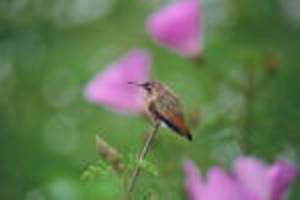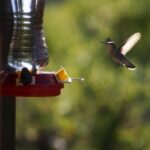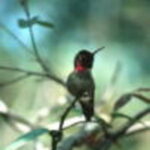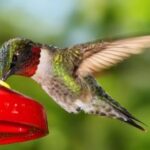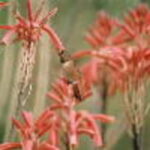Florida seems like the perfect place to be able to watch hummingbirds as they dart from feeder to feeder or from flower to flower. If Florida were one of the first states that comes to mind when considering where one may find these tiny birds, then you would not be far from right. There are at least eight species of hummingbirds that enjoy the weather, and of course, the many beautiful flowers found in Florida. These eight species are Anna’s Hummingbird, Bahamas Woodstar Hummingbird, Black-chinned Hummingbird, Buff-bellied Hummingbird, Calliope Hummingbird, Cuban Emerald Hummingbird, Ruby-throated Hummingbird and Rufous Hummingbird. These beautiful, tiny birds call Florida home from early March until late fall or even early winter.
With eight species of hummingbirds commonly seen in Florida, being able to distinguish between them might be nice. This begins with becoming familiar with the features that set each species apart from the others. The Anna’s Hummingbird has males with metallic green feathers covering their backs, gray feathers covering their breasts, very dark reddish feathers covering their throats and crown. The female Anna’s Hummingbirds have green feathers that cover their back, but they are considerably duller than the male, the females also have lighter gray breasts, white throats that have red spots and white tipped tail feathers.
The Bahamas Woodstar Hummingbird is identified mainly by the male of the species, as it is the more colorful of the sexes. The male has iridescent green feathers that cover its back, rump, hind wings and crown. It also has violet-pink feathers that cover its throat, somewhat of a white collar and buff mixed with olive-green feathers that cover its belly and breast. The male may also have pink-tinged feathers on its forehead. It has a forked tail feathers that are black with orange-brown middles. The female is dull in comparison to the male. The female has pale gray feathers covering its throat, orange-brown feathers on its belly and on its outer tail feathers. This species of hummingbirds are inhabitants of areas that have scrubby vegetation that grows low to the ground, such as gardens in south Florida.
The Black-chinned Hummingbird has males with black feathers that cover their throat; they have purple feathers that create a throat band, white feathers that create a collar as well as green feathers that cover their crown and breast. The female Black-chinned Hummingbird is more colorful than the male with white feathers that cover their breast, their throats are black and white spotted, their sides are buff with white tips and they have a green crown and back
Buff-bellied Hummingbirds do not have many differences between the sexes other than their size; males are usually larger. Both birds have metallic feathers covering their back, crown and throat. Buff colored feathers cover these birds’ sides, belly and tails. The main distinguishable feature these birds have is their white eye rings.
The Calliope Hummingbird is a smaller hummingbird with males weighing about 2.5g and females weighing 2.83g. The purple feathers within the white feathers on the throat that create what looks like whiskers immediately identify the male. The male also has metallic green feathers that cover the back and crown. The female Calliope Hummingbird is different from the male in that it does not have the purple feathers on its white throat creating the whiskered effect. However, the female does have green feathers that cover its back and crown, buff feathers down its sides and its tail feathers have white-tipped corners.
The Cuban Emerald Hummingbird is one of the rarer hummingbird species to be seen in Florida. The male Cuban Emerald Hummingbird is identified by the colors of its feathers covering the tiny body. It has green feathers covering the majority of its tiny body. Its tail feathers are blackish and are white underneath, their lower mandible is pink and their tail is forked. The female has bronze-green to green feathers covering her tiny body with a tail that is dusky violet. Both sexes have a white spot behind their eyes.
The ruby red feathers that are located on the throat and the forked tail of the male bird most easily identify the Ruby – throated Hummingbird. The male Ruby-throated Hummingbird also has emerald green feathers that cover its back. The female Ruby-throated Hummingbird also has emerald green feathers covering its back as well as white feathers on its breast and its tail is rounded with white tips.
Rufous Hummingbird is probably the most common hummingbird in that it is documented in every state within the United States. As the name indicates, the Rufous Hummingbird is predominately covered in rufous hummingbirds. These rufous hummingbirds are found on the crown, tail and down the sides of the male and on the female, they are found on the sides and base of the tail feathers. The male may also have rufous colored feathers covering its back, or these feathers may be green or a combination of green and rufous. Its throat is orange-red and its breast is covered in white feathers. The female has green feathers covering its back and crown and white feathers covering its breast.
When planning a garden to attract these species of hummingbirds, the gardener should consider annuals, vines, perennials, shrubs and trees. Annuals to consider are Garden Balsam, Impatiens, Lemon Mint, Scarlet Sage and Annual Phlox. Vines that hummingbirds prefer are Red Morning Glory, Trumpet Creeper, Carolina Jasmine and Trumpet Honeysuckle. Perennials that should be included in a hummingbird garden are Mexican Butterweed, Cannas, Mexican Cigar Plant, Bromeliads, Scarlet Hibiscus, Standing Cypress, Shrimp Plant, Firecracker Bush, Autumn Sage and Mexican Bush Sage. Shrubs that attract hummingbirds are Flame Flower, Coral Bean, Scarlet Bush, Purple Cestrum, Calico Bush and Turk’s Cap. Finally, trees that are preferred by hummingbirds are Dessert Willow, Orange, Lemon and Grapefruit, Royal Poinciana and Loquat.
